Author Archive
 DMR Hotspot from SharkRF
DMR Hotspot from SharkRF
Amateur adoption of Digital Mobile Radio (DMR) continues to increase, with a number of new innovations playing out. It was way back in 2012 when I wrote this article about DMR for CQ VHF Magazine: TRBO Hits the Amateur Bands.
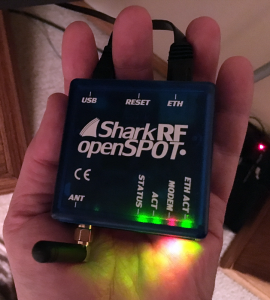 A few years ago, I picked up some used MOTOTRBO gear to use on our local DMR repeater system (MOTOTRBO is Motorola’s version of DMR). Here in Colorado, the Rocky Mountain Ham Radio group has been instrumental in establishing a great network of DMR repeaters, a real asset for Colorado radio amateurs. See Rocky Mountain Ham Radio TRBO/DMR Network. Worldwide, the DMR-MARC organization has created a robust network of MOTOTRBO repeaters in over 60 countries.
A few years ago, I picked up some used MOTOTRBO gear to use on our local DMR repeater system (MOTOTRBO is Motorola’s version of DMR). Here in Colorado, the Rocky Mountain Ham Radio group has been instrumental in establishing a great network of DMR repeaters, a real asset for Colorado radio amateurs. See Rocky Mountain Ham Radio TRBO/DMR Network. Worldwide, the DMR-MARC organization has created a robust network of MOTOTRBO repeaters in over 60 countries.
A more recent development is the establishment of the BrandMeister Network, which promotes more of a homebrew approach to DMR. This evening, the BrandMeister dashboard shows 634 industrial repeaters (commercial equipment), 263 homebrew repeaters and over 1300 hotspots of various types. A variety of DMR hotspots are available, including the DV4mini. I’m not going try to list all of the hotspots available as I’m sure I’ll miss something. The SharkRF openSPOT caught my attention because of this excellent review by John ‘Miklor’ K3NXU. Because of its popularity, the openSPOT is on backorder (price: 182.5 Euro).
This HamRadioConcepts video walks through the setup and basic operation.
I thought the openSPOT would be a good widget to have around the shack. It is a standalone hotspot, so I don’t have to dedicate a computer to it. Also, it is very turnkey…no assembly required…but some configuration to work out. Its user interface is a web page that you access via your local network…nicely done. I got it working in less than one hour and have been fiddling around with it ever since.
Hotspots are a funny item. They have very limited RF range, so their main purpose is to provide local RF access into the network (just like your Wi-Fi hotspot). One role they play is to provide fill-in coverage when no repeater is available. Another role they fill is being a personal device that can be connected to your favorite reflector or talk group.
I should point out that the openSPOT also operates as a D-STAR and Yaesu Fusion (YSF) hotspot. You just change the configuration of the modem and it starts speaking the selected modulation. More surprising is that I was able to use a YSF handheld radio to talk to the openSPOT which routed me to a DMR talkgroup. Yes, a Yaesu YSF radio talking on DMR.
The first thing I noticed when listening to some of the more active talk groups is that it seems like every person getting on the system said “I just got this Tytera MD-380 radio and you are my first DMR contact.” OK, sometimes it was a Connect Systems or Motorola radio but the MD-380 at around $100 is having a big impact. I picked up an MD-380 and while its not quite as nice as my Motorola, I really do like the radio. (Note that there are other low cost DMR radios that have serious technical issues.) There will be other radios on the market…the technology will keep improving and improved models will hit the market. Right now, everyone is wondering who will create a good dualband 2m / 70cm transceiver for DMR.
I see some very strong technology and market trends in play here that are going to impact the ham radio world. First off, DMR is a true industry standard (ETSI), well designed and documented. Second, we are seeing multiple radio vendors offering competitive, low cost transceivers. Third, there is high quality commercial repeater gear available from land mobile providers such as Motorola and Hytera. But there’s one more thing that really tops this off: the number of ham-built products emerging that are focused on DMR. This is classic ham radio adaptation and innovation that leverages commercial gear for ham radio use.
Stay tuned…this is going to be interesting!
73, Bob K0NR
The post DMR Hotspot from SharkRF appeared first on The KØNR Radio Site.
 2017 Mt Herman Winter Activation
2017 Mt Herman Winter Activation
On Saturday, we returned to the Most Radio Active Mountain in Colorado, Mount Herman (W0C/FR-063), for a combination VHF contest, SOTA activation and winter hike. Our radio crew consisted of Steve/WGØAT, Caleb/W4XEN, Joyce/KØJJW and me. I’ve worked Steve forty times on various summits and often when he was activating Mount Herman, but this is the first time we did an activation together. What a treat be on the same summit as the Goathiker! Not only that, Peanut goat came along to supervise the entire operation.
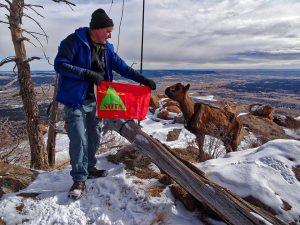
My objective for the day was to chalk up another VHF SOTA activation, while also making some Qs in the VHF contest. For most SOTA activations, I just focus on 2 meters. During a VHF contest, I bring more gear to cover the other bands. The main rig for SSB/CW was my FT-817 driving an Arrow II dualband yagi for 2m and 70 cm. For 6m, I used an inverted Vee dipole supported by a crappie pole. I also had two FT-1D handheld radios listening on 146.52 and 446.0 MHz.
I made 21 contacts on 6m, 2m and 70cm, with 7 grids/mults and a Single Operator Portable score of 164. Not that great of a contest score but it was only a few hours of operating. From a SOTA perspective, this is an attractive number of VHF QSOs in a relatively short time.
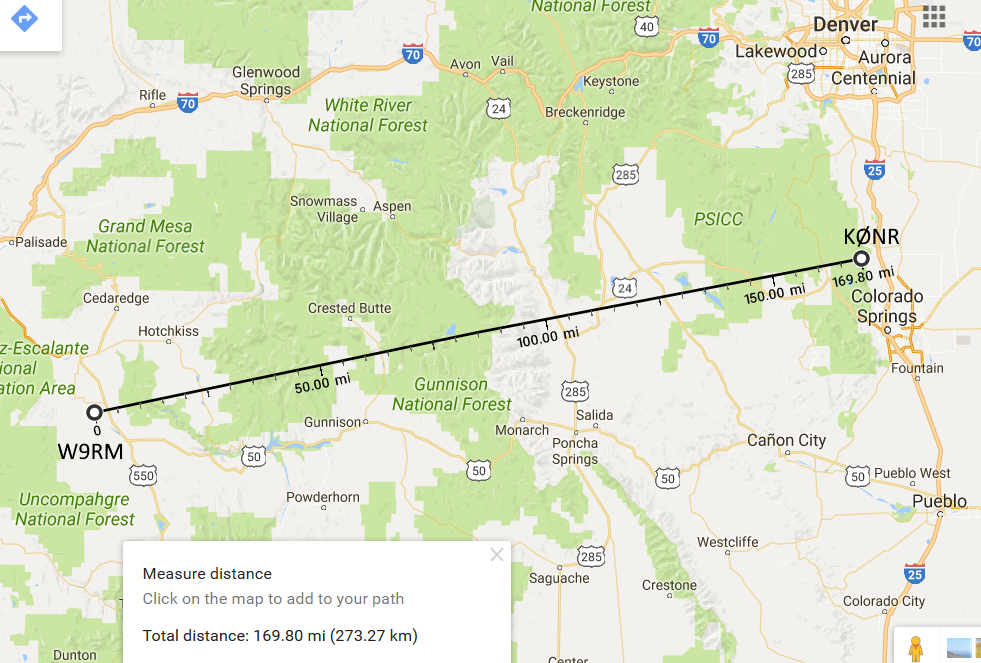 Surprisingly, even during a VHF contest, most of the contacts were on FM with the usual SSB contest stations rather scarce. It was very handy to be able to use 146.52 MHz for the contest, finding a number of casual contesters on that frequency.
Surprisingly, even during a VHF contest, most of the contacts were on FM with the usual SSB contest stations rather scarce. It was very handy to be able to use 146.52 MHz for the contest, finding a number of casual contesters on that frequency.
The high point of the day was working Jay W9RM on the other side of the state in DM58 using 2m CW on 144.210 MHz. The distance was about 170 miles on a path that went over or through several mountain ranges. Not too bad for QRP. (Oh, I guess it doesn’t hurt that W9RM has a serious weak-signal VHF station: 2M-5WL yagi at 50 feet.) This contact demonstrates the advantage of CW and SSB on 2 meters. Most VHF SOTA action is on FM due to the convenience of a 2m FM HT. But FM has poor weak-signal performance so much better range can be achieved with both CW and SSB. When is the last time you made a 170 mile QSO with an FM handheld?
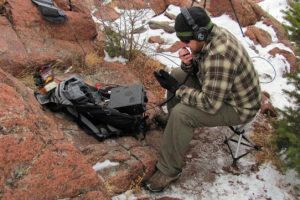
This was the first SOTA activation for Caleb/W4XEN. Judging by the smile on his face, it won’t be his last one either. While I played on VHF, Steve did his usual thing on HF using CW, using a KX3 to drive an end-fed antenna. Caleb did a bit of both HF and VHF, managing to get a nice pile up going on 20m SSB. Joyce made a few contacts on 2m FM but mostly took pictures and occasionally tossed GORP in my direction.
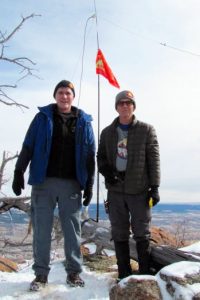
On my last winter activation, my iPhone quit in the cold, so I did not want to rely on it for logging this time. I had a clipboard with my paper log on it, also holding the dual-paddle key. The key moved around a bit and my Morse code sending was sloppy. I don’t work a lot of CW for SOTA but it does come in handy at times, so I’ll be looking at improving my setup.
The 6m inverted Vee worked out OK but it was a little inconvenient to run the coaxial cable to the apex of the antenna. I’ll be looking to swap that antenna out for an end-fed half wave, which is so common on the HF bands for SOTA.
Steve brought along a large umbrella for use as an instant-up wind shelter. That looks like a practical way to block the wind.
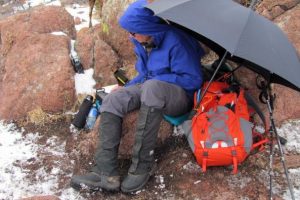
The weather was not great…we had a few patches of blue sky but it was mostly overcast and cold (probably 25 degrees F). We lasted about 2 hours before the cold started to take its toll, then we scooted on down the mountain.

Thanks to Joyce, Steve and Caleb for a great day playing radio in the mountains.
73, Bob KØNR
The post 2017 Mt Herman Winter Activation appeared first on The KØNR Radio Site.
 2017 North America SOTA Events
2017 North America SOTA Events
 Here’s your handy list of North American Summits On The Air (SOTA) activities for 2017, as supplied by Guy N7UN:
Here’s your handy list of North American Summits On The Air (SOTA) activities for 2017, as supplied by Guy N7UN:
- Jan 21-22rd: North America SOTA Winter Activity Weekend + ARRL Jan VHF Contest
- Apr 22-23: North America SOTA Spring Activity Weekend + QRPTTF Spring Event (Apr 22)
- Jun 10-11: North America SOTA Summer Activity Weekend + ARRL June VHF Contest
- Jul 15-16: SOTA optional date + CQ WW VHF Contest
- Aug 5-6: North America SOTA Rocky Mtn Rendezvous + Colorado 14er Event + W7 SOTA Activity Weekend + ARRL UHF (222MHz+) Contest
- Aug 21: SOTA and the Great American Total Solar Eclipse of 2017.
- Sept 9-10: North America SOTA Fall Activity Weekend + ARRL Sept VHF Contest
The post 2017 North America SOTA Events appeared first on The KØNR Radio Site.
 Top Five K0NR Blog Posts For 2016
Top Five K0NR Blog Posts For 2016
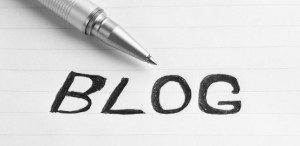 As we approach the end of the year, it is fun to look back to see which blog posts were read the most. It turns out these five blog postings were written in previous years but they are the ones that got the most hits in 2016.
As we approach the end of the year, it is fun to look back to see which blog posts were read the most. It turns out these five blog postings were written in previous years but they are the ones that got the most hits in 2016.
The most read post on k0nr.com was Choose Your 2m Frequency Wisely, an article I wrote that explains the 2m band plan in Colorado. I wrote this one years ago after encountering quite a few folks that did not understand how the band plan is set up. (If you are outside of Colorado, see What Frequency Do I Use on 2 Meters? over on HamRadioSchool.com) The second most read post concerns the use of amateur gear outside the ham bands: Can I Use My Ham Radio on Public Safety Frequencies? Actually, I have two blog postings that cover the same topic but I’ve linked to the one that is up to date. This is a hot topic as many people still believe strongly that no ham gear is legal on Part 90 frequencies (read through the comments on that post). This is why I took the time to write about it, attempting to explain it and educate the ham community.
Another perennial favorite is: Solving the Baofeng Cable Problem. There is a really frustrating problem with how the Windows driver works with certain USB interface chips. Many folks who went out and bought low cost Baofeng (and other) radios got totally hosed up by this. Hence, the need for and the popularity of this blog posting.
Next up is my classic article FM/VHF Operating Guide, written many years ago and continually updated over the years. Mobile radio installations are always a bit of an exploration, so I try to share what I learn when doing one. People seem to appreciate this kind of article and often ask followup questions via email. For whatever reason, my 2012 Jeep Wrangler Radio Install post continues to be a popular post on my blog.
Hey, thanks for stopping by k0nr.com. Best of luck to you in the New Year.
73, Bob K0NR
The post Top Five K0NR Blog Posts For 2016 appeared first on The KØNR Radio Site.
 GMRS: The Other UHF Band
GMRS: The Other UHF Band
I’ve always had a liking for the General Mobile Radio Service (GMRS). It’s a licensed radio service but does not require a technical exam so it works great for basic personal communications. When our kids were young we made good use of GMRS communications. This was back in the Pre-Cellphone Era, shortly after the dinosaurs left the earth. I still have my GMRS license: KAF1068
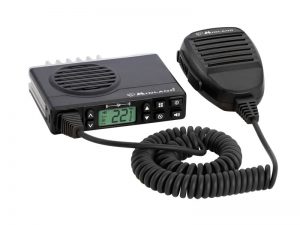
GMRS uses frequencies in the general vicinity of 462 and 467 MHz. When the FCC created the Family Radio Service, they intermingled the FRS and GMRS channels, creating a real mess. See this page for a good explanation of how FRS and GMRS frequencies are arranged. Many of the low cost walkie-talkie radios sold in stores are combination FRS/GMRS radios.
I recently came across this really sweet little GMRS rig, the Midland MXT-100 Micro Mobile GMRS Radio. This thing is nice and small with an external mag-mount antenna for the roof of the car. It only has 5W of output power, which is not much more than a typical FRS/GMRS handheld radio but the external antenna should help a lot. (I’ve heard there are newer models on the way so stay tuned for that.)
I’ve encountered 4WD / Jeep clubs that use FRS radios for on the trail communications. This Midland radio would be a good upgrade for that kind of use, providing additional radio range. Some of these 4WD enthusiasts have gotten their ham ticket via our Technician license class. Ham radio provides a lot more capability but not everyone in their club is likely to get their ham license. GMRS is a great alternative…the other UHF band. It will work for other outdoor, community and club activities that involve “non radio” people.
FCC recently reduced the cost of the GMRS license to $65 for 5 years. I suspect that most people don’t bother with getting a license…but they should. For more detail on GMRS, see the FCC GMRS Page or for some good bedtime reading see the FCC Part 95 Rules.
73, Bob KØNR
The post GMRS: The Other UHF Band appeared first on The KØNR Radio Site.
 This Spewed Out of the Internet #33
This Spewed Out of the Internet #33
 Here’s some more good stuff flowing forth from the interwebz.
Here’s some more good stuff flowing forth from the interwebz.
HamRadioNow has a video of Laura Smith’s (FCC) talk at Pacificon. There’s lots of good info here on FCC enforcement activity. Gary KN4AQ produces some of the most valuable amateur radio video content on the web. How else are you going to see someone from the FCC speak about ham radio?
Sterling/NØSSC and Marty/KC1CWF have started the Phasing Line ham radio podcast, talking ham radio with a younger person’s perspective. They are on episode two…give them a listen. Look for them on the usual podcast feeds, or go here: n0ssc.com
I was interviewed by Eric/4Z1UG on QSO Today. Yeah, probably boring as heck but you’re reading this blog so your standards must not be very high.
The ARRL is cranking up an initiative to encourage collegiate ham radio clubs. Good idea.
DX Engineering visited the new venue (Greene County Fairgrounds) for the Dayton Hamvention. See DX Engineering visits the NEW 2017 Hamvention® venue and the drone video by Greg/W8WW that provides an aerial tour of the fairgrounds. I am looking forward to attending Hamvention next spring, the first time in many years.
Use Phonetics: HamRadioSchool.com republished their classic article on the use of phonetic alphabets. Also, take a look at my Shack Talk article on the same subject.
While reviewing the Technician license exam questions, I noticed that SWR is referred to as “2 to 1” or “1 to 1”. I see this as old school terminology…a ratio can be expressed as a single number: “my SWR is 2.” This triggered some discussion and a KB6NU blog posting.
That’s it for now. Happy interwebzing.
73, Bob K0NR
The post This Spewed Out of the Internet #33 appeared first on The KØNR Radio Site.
 The Cacophony of Digital Voice Continues (Part 2)
The Cacophony of Digital Voice Continues (Part 2)
 This post is a continuation of The Cacophony of Digital Voice Continues (Part 1), so you probably should read that one first.
This post is a continuation of The Cacophony of Digital Voice Continues (Part 1), so you probably should read that one first.
All of the popular amateur digital voice (DV) systems (D-STAR, DMR and YSF) use the AMBE vocoder (voice codec) technology. This technology was developed by Digital Voice Systems, Inc. and is proprietary technology covered by various patents. The use of proprietary technology on the ham bands causes some folks to get worked up about it, especially proponents of an open source world. See my blog posting: Digital Voice at Pacificon and this presentation by Bruce Parens K6BP: AMBE Exposed. Codec2 is an alternative open voice codec developed by David Rowe, VK5DGR. David is doing some excellent work in this space, which has already produced an open codec that is being used on the ham bands. FreeDV is an umbrella term for this open codec work. Here’s a recent video of a presentation on FreeDV by VK5DGR.
It will be interesting to see if and how Codec2 gets adopted in a DV world already dominated by AMBE. After all, a new codec is another contributor to the digital cacophony. On the HF bands, it is easier to adopt a new mode if it can be implemented via a soundcard interface (which FreeDV can do). Any two hams can load up the right software and start having a QSO. The same is true for weak-signal VHF/UHF via simplex. (Note that Flexradio also supports FreeDV, showing how Software Defined Radio (SDR) has an advantage with adopting new technology.) VHF/UHF repeaters are trickier because you must have a solution for both the infrastructure (repeaters and networks) as well as the user radios.
The vast majority of digital repeaters support just one digital format. For example, a D-STAR repeater does not usually repeat DMR or YSF transmissions. Interestingly, DMR and YSF repeaters often support analog FM via mixed mode operation for backward compatibility. It is definitely possible to support multiple digital formats in one repeater, but the question is will large numbers of repeater owners/operators choose to do that? With existing DV systems, the networking of repeaters is unique to each format which represents another barrier to interchangeability. In particular, most of the DMR infrastructure in the US is MOTOTRBO, which won’t ever support D-STAR or YSF.
In the case of a new vocoder, we can think of that as just a new format of bits being transported by the existing DV protocol. DMR, for example, does not actually specify a particular vocoder, it’s just that the manufacturers developing DMR equipment have chosen to use AMBE technology. So from a technical viewpoint, it is easy to imagine dropping in a new vocoder into the user radio and having it work with other identical radios. Of course, these radios would be incompatible with the existing installed base. Or would they? Perhaps we’d have a backwards compatibility mode that supports communication with the older radios. This is another example of putting more flexibility into the user radio to compensate for DV incompatibilities.
One objection to AMBE is the cost of the technology, especially when compared to free. When D-STAR radios first started using AMBE codec chips, the chip cost was rumored to be $25 to $50, but I don’t have a solid source on that. Now, I see that Tytera is selling a DMR handheld at around $100, including AMBE technology inside, so the codec can’t be very expensive. If a free codec starts to be a credible threat, it will put additional pricing pressure on the AMBE solution.
A potential advantage of Codec2 is superior performance at very low signal-to-noise ratio. We’ve all experienced the not-too-graceful breakup of existing DV transmissions when signals get weak. Some of the Codec2 implementations have shown significant improvement over AMBE at low signal levels.
Conclusions
Repeating a key conclusion from Part 1:
- For the foreseeable future, we will have D-STAR, DMR and YSF technologies being used in amateur radio. I don’t see one of them dominating or any of them disappearing any time soon.
Adding in these conclusions for Part 2:
- Codec2 will struggle to displace the proprietary AMBE vocoder, which is well-established and works. The open source folks will promote codec2 but it will take more than that to get it into widespread use. Perhaps superior performance at low signal levels will make the difference.
- Repeater owner/operators will continue to deploy single-DV-format repeaters. This will make multiformat radios such as the DV4mobile be very attractive. In other words, we will deal with the digital cacophony by having more flexible user radios. This will come at a higher price initially but should drop over time.
Repeating this one from Part 1:
- A wild card here is DMR. It benefits from being a commercial land mobile standard, so high quality infrastructure equipment is available (both new and used gear). And DMR is being embraced by both land mobile providers (i.e., Motorola, Hytera) and suppliers of low cost radios (i.e., Tytera, Connect Systems). This combination may prove to be very powerful.
Well, those are my thoughts on the topic. I wish the DV world was less fragmented but I don’t see that changing any time soon. What do you think is going to happen?
73, Bob KØNR
The post The Cacophony of Digital Voice Continues (Part 2) appeared first on The KØNR Radio Site.












